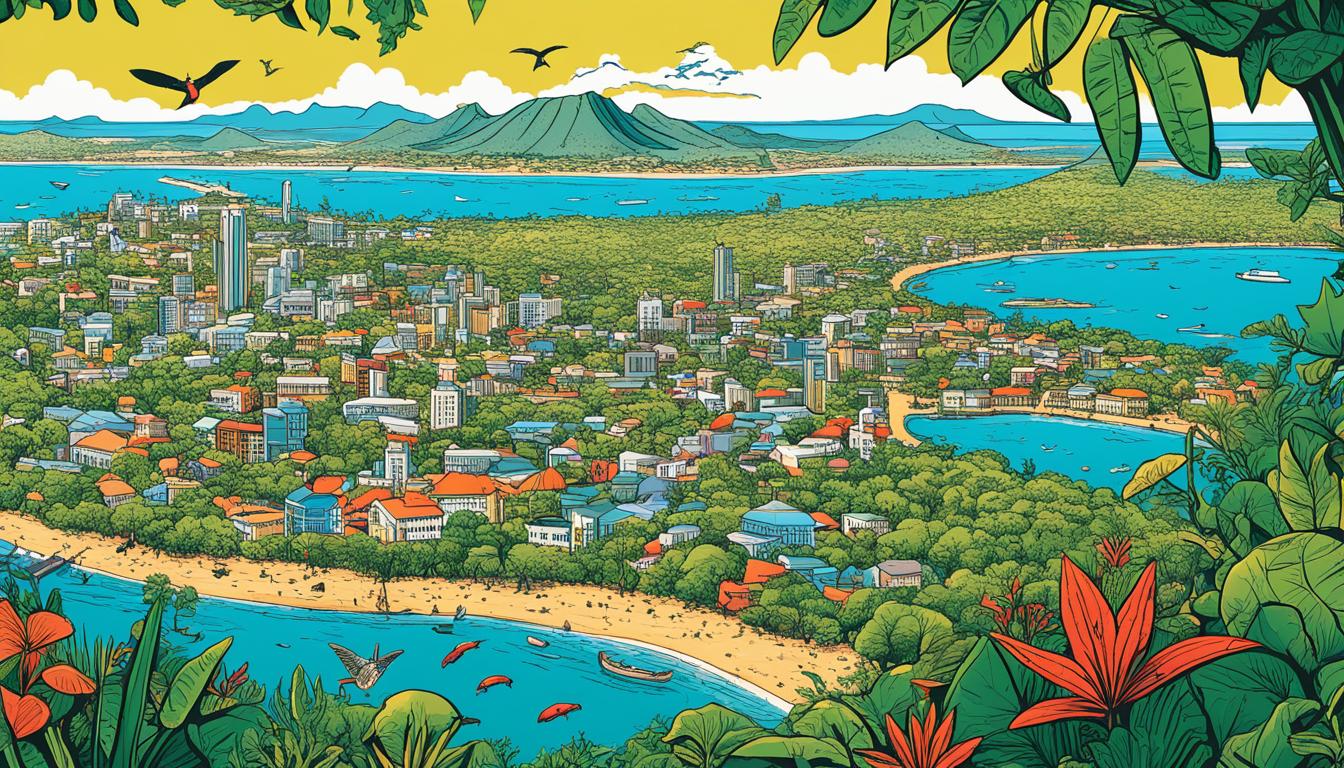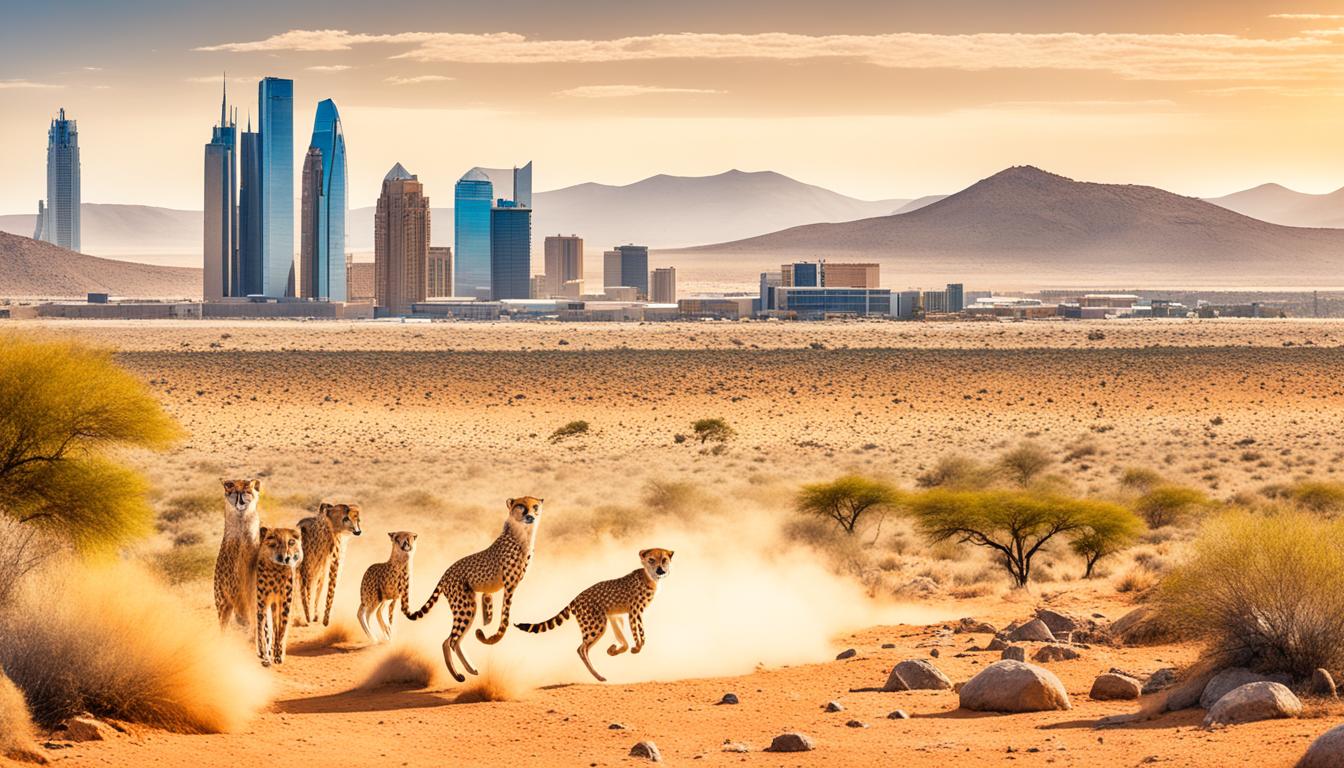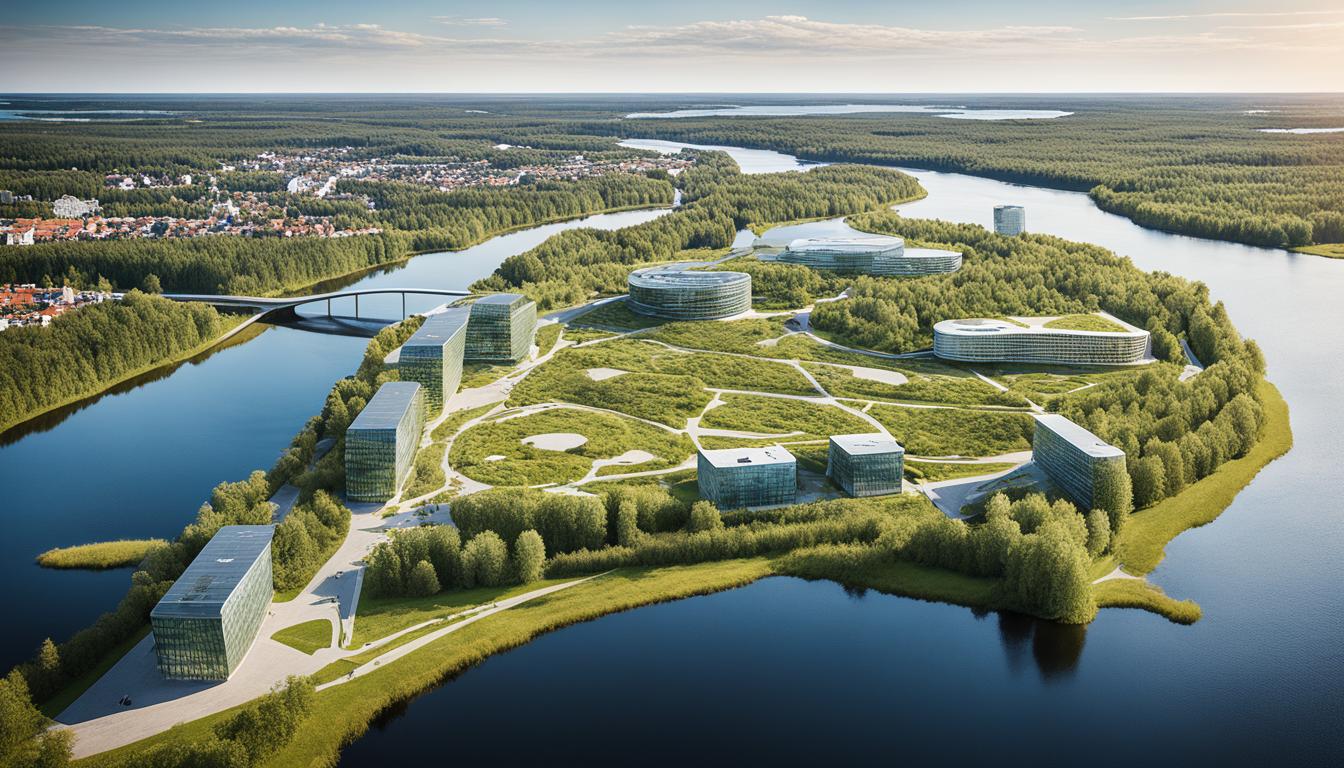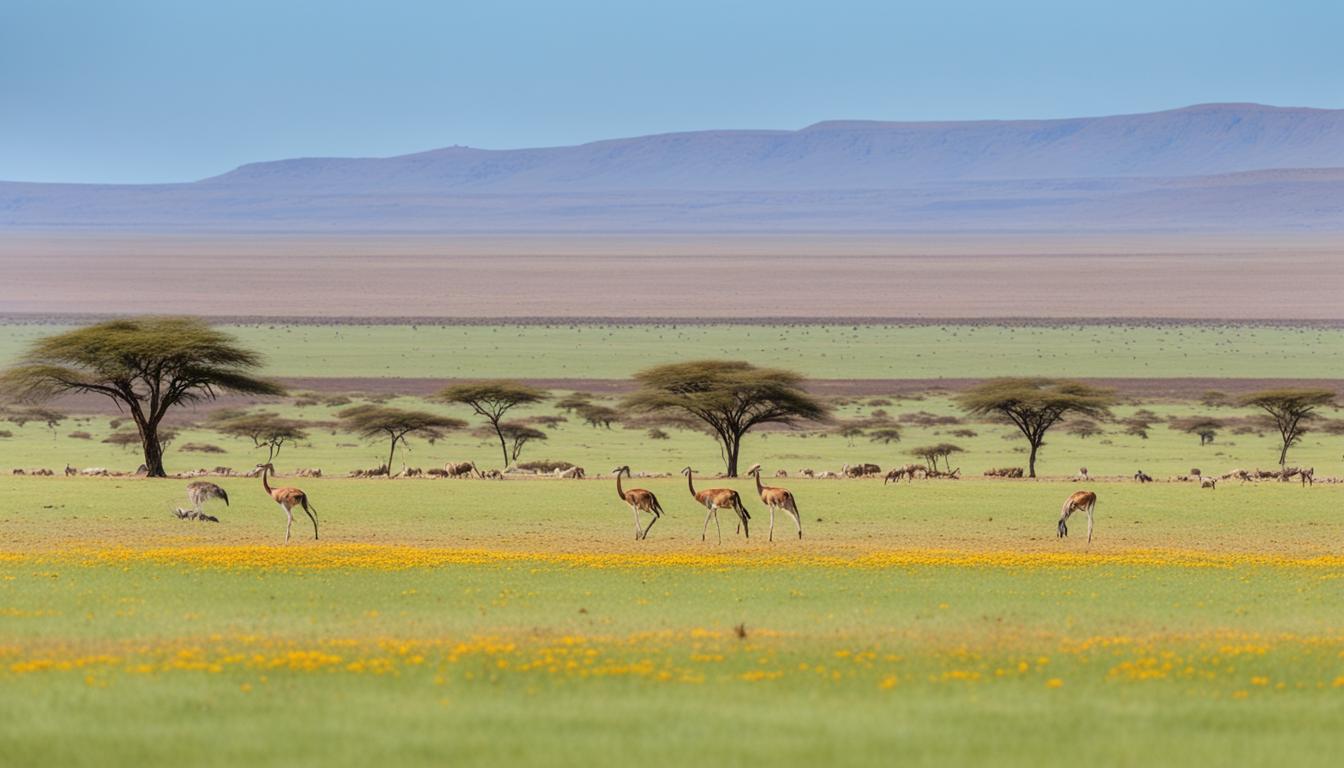Myanmar (formerly Burma) Biodiversity and the Built Environment
Did you know that Myanmar, formerly known as Burma, is home to a staggering array of plant and animal species? This Southeast Asian country boasts one of the richest biodiversities in the world. From majestic elephants to exotic orchids, Myanmar’s diverse ecosystem is a treasure trove waiting to be explored.
Key Takeaways:
- Myanmar is renowned for its incredible biodiversity, housing a wide range of plant and animal species.
- The country’s flora and fauna contribute to vital ecosystem services, including pollination, nutrient cycling, and seed dispersal.
- Unfortunately, Myanmar’s biodiversity faces various threats such as deforestation, illegal wildlife trade, and climate change.
- Conservation efforts in Myanmar involve the establishment of protected areas, stakeholder engagement, and sustainable development practices.
- The integration of traditional architectural elements and sustainable design principles showcases Myanmar’s commitment to preserving both its cultural heritage and the environment.
The Importance of Biodiversity in Myanmar
Myanmar’s biodiversity plays a crucial role in maintaining the balance of ecosystems, not only within the country but also on a global scale. The diverse array of flora and fauna found in Myanmar contributes to the health and vitality of these ecosystems, providing essential services that support life on Earth.
The rich biodiversity in Myanmar supports a wide range of ecosystem services. Species native to Myanmar play a vital role in pollination, ensuring the reproduction and sustainability of plant populations. They also contribute to seed dispersal, facilitating the spread of plant species and promoting genetic diversity. Additionally, the flora and fauna in Myanmar assist in nutrient cycling, maintaining nutrient-rich soil and supporting healthy ecosystems.
Furthermore, the biodiversity in Myanmar enhances the resilience of ecosystems to environmental changes. By having a variety of species with different ecological functions, these ecosystems can better adapt to disturbances and maintain their stability. This resilience is crucial in the face of ongoing climate change and other environmental challenges.
Aside from its ecological significance, Myanmar’s biodiversity provides numerous benefits to human communities. The country’s flora and fauna offer a source of food, with traditional dishes incorporating locally sourced ingredients. The rich biodiversity also serves as a potential source of medicinal products, as many plant species in Myanmar have pharmaceutical properties. Furthermore, the natural resources derived from Myanmar’s biodiversity offer livelihood opportunities for local communities, such as sustainable harvesting practices and ecotourism for wildlife enthusiasts.
Preserving a Unique Heritage
“The diverse flora and fauna of Myanmar represent a valuable treasure, deserving of our utmost protection and conservation efforts.” – Dr. Aungedwin, Biodiversity Researcher
It is crucial to recognize the importance of Myanmar’s biodiversity and work towards its preservation. By protecting the unique flora and fauna found in Myanmar, we can safeguard the delicate balance of ecosystems and ensure the continued provision of ecosystem services. This will not only benefit local communities but also contribute to the global conservation of biodiversity.
Stay tuned for the next section, where we will delve into the threats that Myanmar’s biodiversity faces and explore the conservation efforts being undertaken to mitigate these challenges.
Threats to Biodiversity in Myanmar
Despite its rich biodiversity, Myanmar’s ecosystems face numerous threats that endanger the survival of many species.
- Improper land use: Improper land use practices such as deforestation and habitat destruction are major contributors to the decline of biodiversity in Myanmar. These activities result in the loss of crucial habitat for many species, disrupting ecosystems and threatening their survival.
- Illegal hunting and trade: The illegal hunting and trade of wildlife pose a significant threat to biodiversity in Myanmar. Poaching for bushmeat, traditional medicines, and exotic pets has led to the decline of various animal species. This unsustainable practice disrupts ecological balance and diminishes the genetic diversity within populations.
- Invasive species: The introduction of invasive species has had devastating effects on Myanmar’s native flora and fauna. These non-native species outcompete local species for resources, disrupt natural ecosystems, and can drive native species to extinction. The spread of invasive species is often facilitated by human activities such as international trade and transportation.
- Infrastructure development: The rapid development of infrastructure in Myanmar, including roads, dams, and urban expansion, has significant consequences for biodiversity. Construction projects can lead to habitat fragmentation, which isolates populations and reduces genetic diversity. Additionally, infrastructure development often involves the degradation or destruction of important ecosystems.
- Climate change: Myanmar is vulnerable to the impacts of climate change, which poses a serious threat to its biodiversity. Rising temperatures, changing rainfall patterns, and increased frequency of extreme weather events can disrupt ecosystems, alter species distributions, and lead to the loss of habitat. These changes can have cascading effects on the entire ecosystem, affecting both flora and fauna.

In order to protect Myanmar’s rich biodiversity, it is crucial to address these threats and implement sustainable conservation measures. This requires a collaborative effort involving government agencies, local communities, and international organizations. By mitigating improper land use, combating illegal hunting and trade, preventing the introduction of invasive species, promoting sustainable infrastructure development, and adopting climate change adaptation strategies, Myanmar can safeguard its unique species and ensure their survival for future generations.
Conservation Efforts in Myanmar
Myanmar is firmly committed to the conservation of its rich biodiversity through various initiatives and partnerships. The country recognizes the importance of protecting its natural assets and has established a network of protected areas to safeguard key habitats and species.
Stakeholder engagement plays a crucial role in Myanmar’s conservation efforts. The government collaborates with local communities, organizations, and experts to develop and implement effective strategies for biodiversity conservation. This inclusive approach ensures that the needs and perspectives of all stakeholders are taken into account, promoting a sense of ownership and long-term sustainability.
Furthermore, Myanmar is dedicated to achieving sustainable development by integrating conservation efforts across sectors. By recognizing the close link between biodiversity conservation and resource management, the country strives to balance economic growth with environmental preservation and the well-being of its people.
“Conservation is not a standalone effort; it is an integral part of Myanmar’s journey towards a sustainable future. By protecting our natural heritage, we ensure the well-being of present and future generations.”
The Role of Protected Areas
Protected areas are at the forefront of biodiversity conservation in Myanmar. These designated zones provide a safe haven for native flora and fauna, preserving their habitats and supporting their survival. Protected areas also serve as vital corridors, enabling the movement of species and maintaining ecological connectivity.
Through strict regulations and monitoring, Myanmar’s protected areas help combat illegal activities such as poaching, logging, and illegal wildlife trade. By preventing these destructive practices, the country preserves its unique biodiversity and contributes to global efforts in wildlife conservation.
Community Participation and Education
Myanmar actively engages local communities in conservation efforts to foster a sense of stewardship and build awareness about the importance of sustainable resource management. Community-based initiatives empower individuals to take an active role in preserving their natural surroundings and livelihoods.
Education and capacity-building programs are also integral to Myanmar’s conservation strategies. By providing knowledge and skills, these programs empower individuals and communities to contribute to biodiversity conservation through sustainable practices and responsible use of natural resources.
Conservation Success Stories
Myanmar has achieved significant milestones in biodiversity conservation. For example, the country has successfully reintroduced several endangered species into their natural habitats, boosting their populations and ensuring their long-term survival.
Collaborative efforts have led to the recovery of key ecosystems, such as mangrove forests and wetlands, which play a crucial role in climate regulation and supporting a wide range of biodiversity. These successes showcase Myanmar’s dedication to biodiversity conservation and its positive impact on the environment.

The Status and Trends of Biodiversity in Myanmar
Myanmar is home to a remarkable array of plant and animal species, showcasing its incredible biodiversity. Scientific studies and comprehensive surveys have documented over 11,000 plant species and a diverse range of mammals, birds, reptiles, amphibians, and fish in Myanmar’s ecosystems. These documented species represent a fraction of the actual biodiversity in the country, indicating that there is much more to be discovered and understood.
The plant species in Myanmar are incredibly diverse, with various types of vegetation ranging from lush forests to unique grasslands. This botanical richness provides essential habitats and resources for the country’s wildlife.
The mammal species in Myanmar showcase the country’s diverse landscapes and habitats. From the elusive clouded leopard to the iconic Asian elephant, these species play vital roles in maintaining the ecological balance of the ecosystems they inhabit.
Myanmar’s bird species are equally impressive. The country is a haven for birdwatchers, with over 1,000 documented species. From the vibrant Asian fairy-bluebird to the graceful white-throated kingfisher, the avian diversity in Myanmar is a sight to behold.
The reptile species found in Myanmar include various snakes, turtles, and lizards. These fascinating creatures contribute to the overall biodiversity of the country’s ecosystems, playing essential roles in balancing the predator-prey dynamics and ecological processes.
Amphibians, such as frogs and salamanders, thrive in the wetlands and forested areas of Myanmar. These species are indicators of healthy ecosystems and are crucial for maintaining the ecological integrity of their habitats.
The fish species found in Myanmar’s rivers, lakes, and coastal areas display a stunning array of adaptations and ecological niches. From the majestic Arapaima to the colorful Siamese fighting fish, the aquatic biodiversity in Myanmar is teeming with life.
While these documented species provide valuable insights into Myanmar’s biodiversity, it is important to note that more comprehensive surveys are needed to obtain a more accurate inventory of the country’s plant and animal species. These surveys will help scientists and researchers gain a deeper understanding of Myanmar’s ecosystems and implement more effective conservation strategies.
| Species | Number of Documented Species |
|---|---|
| Plants | Over 11,000 |
| Mammals | |
| Birds | |
| Reptiles | |
| Amphibians | |
| Fish |
The Role of Indigenous Knowledge in Biodiversity Conservation
Indigenous communities in Myanmar have played a significant role in the conservation of biodiversity. Their traditional farming practices and local knowledge have contributed to the preservation of plant genetic diversity and sustainable resource management. By recognizing and including indigenous knowledge systems in biodiversity conservation efforts, we can amplify the positive impact of these communities.
Indigenous communities possess a deep understanding of the land and its ecosystems, accumulated over generations through close interactions with nature. Their traditional farming practices, such as agroforestry and rotational farming, promote soil fertility and minimize the use of chemical inputs. These sustainable farming methods not only preserve the environment but also ensure food security for local populations.
Furthermore, indigenous communities hold valuable local knowledge about plant species, their medicinal properties, and their ecological interdependencies. This knowledge has guided the sustainable use of natural resources, preventing overexploitation and maintaining the delicate balance of ecosystems. By integrating local knowledge with scientific research, we can enhance our understanding of plant genetic diversity and develop effective conservation strategies.
“The indigenous communities of Myanmar possess invaluable wisdom when it comes to sustainable resource management. Their practices are rooted in centuries of living harmoniously with the environment.” – Dr. Aye Aye Soe, Biodiversity Researcher
Recognizing the importance of indigenous knowledge, initiatives are being undertaken to engage indigenous communities in biodiversity conservation efforts. This involves establishing partnerships and empowering local communities to participate in decision-making processes regarding natural resource management. By valuing their wisdom and ensuring their voices are heard, we can foster a sense of ownership and responsibility towards biodiversity conservation.
The Significance of Plant Genetic Diversity
Plant genetic diversity, a result of indigenous knowledge and traditional farming practices, plays a crucial role in sustaining ecosystems and securing our future food and medicine sources. Indigenous communities have preserved and propagated diverse plant varieties, ensuring resilience against environmental changes and providing valuable genetic resources for crop improvement projects.
Enhancing Sustainable Resource Management
Indigenous communities’ sustainable resource management practices extend beyond agriculture. They encompass various aspects of resource utilization, including water management, forestry, and wildlife conservation. By adopting these practices and integrating them into broader conservation strategies, we can foster sustainable development and preserve biodiversity for future generations.

Indigenous knowledge offers a valuable perspective and a profound connection to the natural world. By embracing the wisdom of indigenous communities, we can enhance biodiversity conservation efforts and ensure a sustainable future for Myanmar’s ecosystems.
Eco-friendly Buildings and Sustainable Architecture in Myanmar
In Myanmar, sustainable development and green infrastructure are brought to life through remarkable eco-friendly buildings and sustainable architecture. These structures seamlessly blend cultural preservation with modern functionality, placing a strong emphasis on sustainability and environmental consciousness.
Green building designs and environmentally friendly structures are at the forefront of Myanmar’s construction practices. Architects and developers in the country prioritize sustainable materials, energy-efficient systems, and innovative design principles to minimize the environmental impact of buildings and create a harmonious coexistence with nature.
One of the notable aspects of eco-friendly buildings in Myanmar is the integration of traditional architectural elements and aesthetics. By incorporating cultural elements into the design, these structures celebrate Myanmar’s rich heritage while embracing modern functionality. This approach not only ensures cultural preservation but also creates unique architectural identities that resonate with both locals and visitors.
Furthermore, sustainable construction practices play a crucial role in the development of eco-friendly buildings. The use of renewable energy sources, such as solar panels and wind turbines, helps reduce reliance on fossil fuels and mitigates greenhouse gas emissions. Additionally, innovative water conservation systems and efficient waste management strategies are implemented to enhance resource efficiency and reduce the environmental footprint of these structures.
Let’s take a closer look at an example of an eco-friendly building in Myanmar:
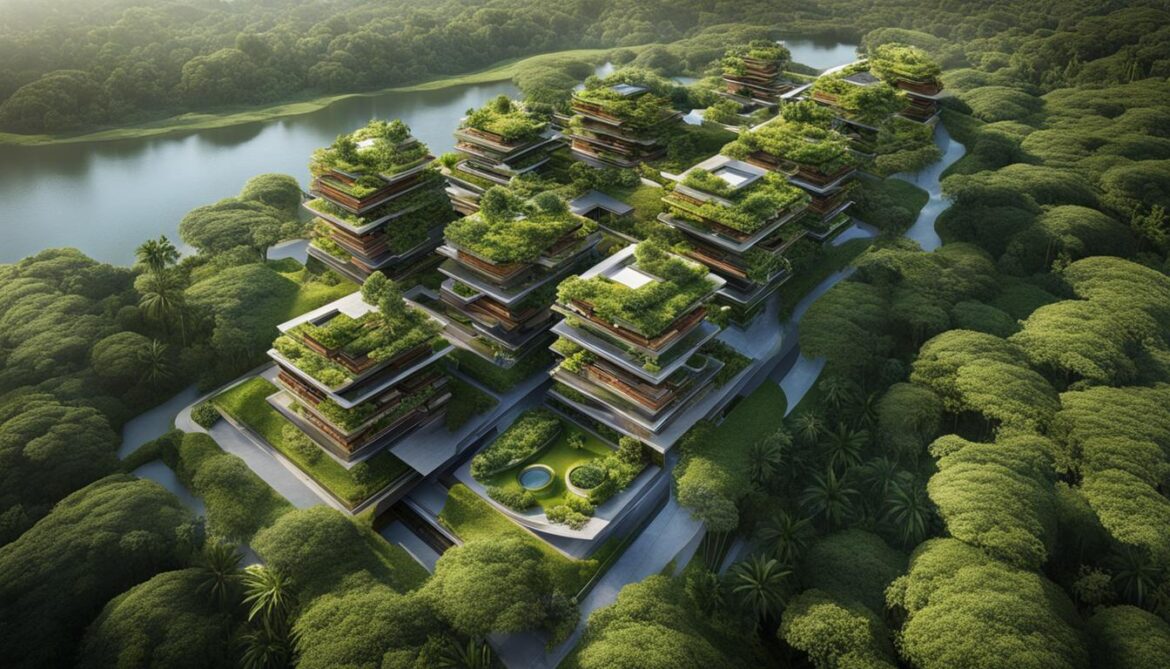
Example: Green Office Space in Yangon
A prime example of sustainable architecture in Myanmar is the Green Office Space located in Yangon, the country’s largest city. This state-of-the-art office building incorporates various environmentally friendly features that promote energy efficiency and reduce environmental impact.
| Key Features | Benefits |
|---|---|
| Green roof with vegetation | – Provides natural insulation and reduces heat island effect – Improves air quality and reduces stormwater runoff |
| Solar panels | – Generates clean and renewable energy – Lowers electricity consumption from the grid |
| Efficient HVAC system | – Reduces energy usage for heating and cooling – Enhances indoor air quality and occupant comfort |
| Water-saving fixtures | – Minimizes water consumption and promotes conservation |
| Recycling facilities | – Encourages waste management and recycling practices |
“The Green Office Space in Yangon serves as a prime example of how sustainable architecture can be seamlessly integrated into urban settings. By incorporating green building designs and implementing sustainable construction practices, Myanmar demonstrates its commitment to environmental stewardship and creates spaces that enhance the well-being of its occupants.”
Eco-friendly buildings and sustainable architecture in Myanmar not only contribute to the conservation of the environment but also inspire a shift towards greener and more sustainable approaches to urban development. Through innovation, cultural preservation, and modern functionality, Myanmar is setting an example for sustainable construction practices that prioritize the well-being of both people and the planet.
Traditional Typologies and Materials in Sustainable Architecture
The architectural design of buildings in Myanmar incorporates traditional typologies and materials, showcasing a seamless blend of cultural heritage and sustainable practices. By using structural timber frames, red bricks, timber vents, and movable shutters, Myanmar embraces its traditional architecture while promoting sustainable and eco-friendly construction methods.
The use of structural timber frames not only provides strength and durability to buildings but also showcases the natural beauty of wood. Timber frames have been used for centuries in traditional Myanmar architecture and continue to be favored for their aesthetic appeal and sustainable qualities.

Another essential element in sustainable architecture is the use of red bricks. These locally sourced building materials have a low carbon footprint and offer excellent thermal insulation. Red bricks are renowned for their durability and contribute to energy efficiency and sustainable design practices.
The inclusion of timber vents in building designs allows for natural ventilation, reducing the need for artificial cooling systems. These vents allow airflow while maintaining privacy and security within the structure. The use of timber vents aligns with traditional architectural principles that prioritize natural ventilation and air circulation.
Using traditional materials not only preserves the cultural heritage of Myanmar but also promotes sustainable and environmentally conscious design. The incorporation of structural timber frames, red bricks, and timber vents showcases a commitment to sustainable practices while paying homage to the country’s traditional architecture.
Movable shutters are another feature that adds both functionality and aesthetic value to sustainable architecture in Myanmar. These shutters can be adjusted to control sunlight, ventilation, and privacy, reducing energy consumption and creating a comfortable indoor environment.
The integration of traditional typologies and materials in sustainable architecture in Myanmar is a testament to the country’s commitment to preserving cultural heritage while embracing sustainable design. By combining traditional architectural elements with modern construction techniques, Myanmar creates buildings that are not only visually appealing but also environmentally friendly.
Sustainable Healthcare for Rural Communities in Myanmar
The healthcare infrastructure in Myanmar plays a vital role in providing sustainable healthcare for rural communities. In areas with challenging geographical conditions, such as during the rainy season, the design of healthcare facilities takes into account the needs of the local population. These facilities aim to address accessibility issues and provide comprehensive care, including services for maternal and child healthcare.
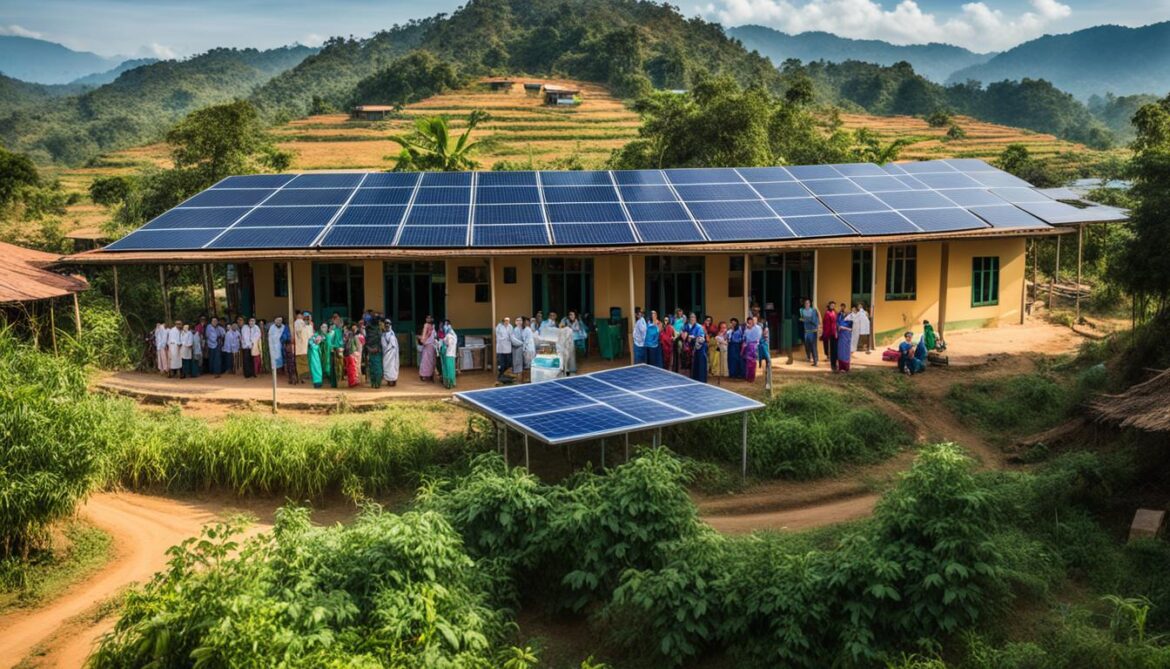
One key aspect of healthcare access in rural areas is the establishment of covered walkways. These walkways connect different parts of the healthcare facility, allowing patients to navigate easily and protecting them from inclement weather. The covered walkways also provide a welcoming and accessible environment for patients, improving their overall healthcare experience.
In addition to covered walkways, healthcare facilities in rural Myanmar prioritize the construction of isolation wards. These wards are equipped to handle infectious diseases and prevent the spread of infections to the wider community. By providing dedicated spaces for isolation, healthcare facilities can effectively manage outbreaks and ensure the safety of both patients and healthcare workers.
Maternal and child healthcare is another essential component of rural healthcare in Myanmar. Facilities are designed to cater to the unique needs of expecting mothers and young children, ensuring that they receive appropriate care and support. This includes prenatal care, safe delivery services, immunization programs, and pediatric care, all of which contribute to improving maternal and child health outcomes.
Comprehensive care is at the heart of sustainable healthcare in rural Myanmar. Healthcare facilities aim to provide a wide range of services to meet the diverse needs of the local population. This includes primary healthcare, preventive care, diagnostic services, treatment options, and rehabilitative support. By offering comprehensive care, healthcare facilities play a crucial role in promoting community health and well-being.
Overall, sustainable healthcare in rural Myanmar is focused on improving healthcare access, ensuring the provision of a covered walkway, establishing isolation wards, and delivering comprehensive care, including services for maternal and child healthcare. These efforts strive to address the unique challenges faced by rural communities and promote equitable access to quality healthcare.
Integration of Traditional and Contemporary Architecture in Myanmar
The architecture in Myanmar seamlessly integrates traditional elements with modern features, creating a harmonious blend of past and present. By fusing traditional and contemporary architecture, buildings in Myanmar reflect the cultural identity of the country while meeting the functional requirements of modern design. This integration preserves cultural heritage and showcases the adaptability of traditional design principles.
“The integration of traditional design principles with modern features allows us to create buildings that are not only visually stunning but also rooted in our cultural heritage. It’s a way for us to preserve our traditions while embracing progress and modernity.” – Aung Kyaw Moe, renowned architect.
Myanmar’s architectural style pays homage to its rich history and cultural preservation efforts. Traditional design principles are carefully incorporated into the construction of new buildings, ensuring a harmonious coexistence with modern features. This approach not only enhances the aesthetic appeal of the architecture but also serves as a reminder of Myanmar’s architectural heritage.
An example of this integration can be seen in the use of traditional materials such as teakwood, red bricks, and thatched roofs alongside contemporary construction techniques and materials. These modern features, such as efficient insulation, energy-saving technologies, and sustainable building materials, enhance the functionality and environmental performance of the structures without compromising their cultural significance.

The incorporation of traditional and contemporary elements in Myanmar’s architecture also reflects the country’s commitment to sustainable development. By blending cultural preservation with modern functionality, Myanmar showcases how architecture can evolve to meet the needs of the present while honoring the past.
Prominent Examples of Traditional and Contemporary Architecture in Myanmar
Several notable examples of traditional and contemporary architecture can be found throughout Myanmar.
- Shwedagon Pagoda: One of the most iconic structures in Myanmar, the Shwedagon Pagoda seamlessly combines traditional Burmese architectural elements with modern restorations.
- Yangon Central Railway Station: This grand railway station features colonial-era architecture blended with traditional Burmese design principles, creating a unique fusion of styles.
- Bagan Temples: The ancient temples of Bagan exemplify the integration of traditional and contemporary architecture, showcasing Myanmar’s rich cultural heritage.
These examples demonstrate how traditional design principles and modern features can coexist harmoniously, creating architectural masterpieces that are not only functional but also visually captivating.
In text must include SEO relevant keywords – cultural preservation, modern features, traditional design principles, architectural style.
Conclusion
Myanmar’s commitment to biodiversity conservation and sustainable development places the country at the forefront of regional and global conservation efforts. By prioritising conservation and addressing the challenges faced, Myanmar is dedicated to safeguarding its unique species and preserving its rich biodiversity for future generations. The country’s ongoing conservation initiatives serve as an exemplary model for sustainable development and ecosystem protection.
With its diverse ecosystems and abundant wildlife, Myanmar recognises the significance of preserving its natural resources. By implementing measures for habitat conservation, sustainable land use, and wildlife protection, Myanmar aims to strike a balance between development and environmental stewardship.
Through the establishment of protected areas and collaboration with stakeholders, Myanmar demonstrates its dedication to preserving its ecosystems and promoting biodiversity preservation. These efforts not only support the country’s own ecological heritage but also contribute to the larger global conservation movement.
FAQ
What is the significance of biodiversity in Myanmar?
Myanmar’s biodiversity is crucial for maintaining ecosystem balance and providing various ecosystem services. It also offers food, medicine, and livelihood opportunities for local communities.
What are the major threats to biodiversity in Myanmar?
The threats to biodiversity in Myanmar include improper land use, illegal hunting and trade of wildlife, invasive species, infrastructure development, and climate change.
What conservation efforts are being undertaken in Myanmar?
Myanmar has established protected areas and is actively collaborating with stakeholders to develop and implement conservation strategies. The country is committed to sustainable development and the integration of conservation efforts across sectors.
How many documented species are there in Myanmar?
Myanmar has documented over 11,000 plant species and a diverse range of mammals, birds, reptiles, amphibians, and fish. However, further comprehensive surveys are needed to provide a more accurate inventory of Myanmar’s biodiversity.
What role do indigenous communities play in biodiversity conservation?
Indigenous communities in Myanmar have contributed significantly to biodiversity conservation through their traditional farming practices and local knowledge. They have played a critical role in preserving plant genetic diversity and sustainable resource management.
How is sustainable architecture practiced in Myanmar?
Myanmar showcases its commitment to sustainable development and green infrastructure through eco-friendly buildings and sustainable architecture. These structures blend cultural preservation with modern functionality and prioritize sustainability and environmental consciousness.
What traditional typologies and materials are used in sustainable architecture in Myanmar?
Sustainable architecture in Myanmar incorporates traditional elements such as structural timber frames, red bricks, timber vents, and movable shutters. These not only honor the country’s cultural heritage but also promote sustainable and eco-friendly construction practices.
How does healthcare infrastructure in Myanmar address the needs of rural communities?
Healthcare facilities in Myanmar design their infrastructure, considering the needs of local populations, especially in areas with challenging geographical conditions. These facilities aim to address accessibility issues and provide comprehensive care, including services for maternal and child healthcare.
How does Myanmar integrate traditional and contemporary architecture?
Myanmar seamlessly integrates traditional elements with modern features in its architectural designs, creating a harmonious blend of the past and the present. By fusing traditional and contemporary architecture, the buildings in Myanmar reflect the cultural identity of the country while meeting the functional requirements of modern design.
What is the significance of Myanmar’s conservation efforts?
Myanmar’s commitment to biodiversity conservation and sustainable development positions the country as a key player in regional and global initiatives. By prioritizing conservation and addressing challenges, Myanmar aims to safeguard its unique species and preserve its rich biodiversity for future generations.



